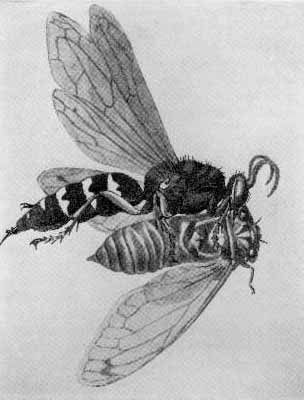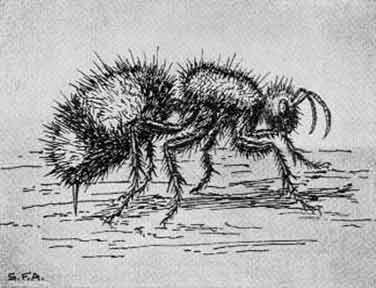By S. F. AARON
Nature Magazine, March 1932
Page 1 | Page 2 [1] | Page 3 [2]
Are there any more vivid memories of childhood than those of the berry picking and swimming expeditions that were turned into swift, ragged retreats by hornets, bumble-bees and yellow-jackets?
These "ladies" for only the females have stings have drive n their bayonets home into many a tan-coated calf, and turned vacation days into days of pain and anger. And it is little wonder that the recipients of their attention have seldom ventured, either as children or adults, co pursue the interesting study of the why and wherefore of their stinging ways, but rather to avoid them most religiously. The loss has not been entirely to the attacking contingents, for the social stinging Hymenoptera, as are other creatures endowed with venomous stings, are far more fascinating than dangerous. Not all the entertainment they provide is contained in their hot tails.
Of species endowed with venomous stings which, to be precise, are connected with poison secreting glands, are separate from teeth or mandibles and are located at the posterior end of the body the arthropods have by far the greater number. Of them the aculeate Hymenoptera, or ants, bees and wasps, being the sole insects distinctly so armed, are exceedingly more plentiful and better known.

A SAND HILL HORNET CARRIES HOME ITS PARALYZED VICTIM
The bees and wasps, both social and solitary, are the most important sisters in the stinging sorority. Certain ants possess protective stings, though, at least in North America, they are far from seriously venomous, even when numerously cooperative.
Because he tackles every kind and condition it is the enthusiastic collector of the Hymenoptera who gathers very definite and comparative knowledge of insect stings. However expert he may be in poison bottling his specimens from flowers or fruit, he can be sure to receive an extended thrust of an abdomen now and then, and if he is a student of the social habits and nest-building he runs a very large chance of maddening those active, four winged ladies who are jealous of their rights. The solitary forms are never inclined to resent minor interference.
The relative power of the venom of stings is largely a matter of the physical condition of the victim and of individual susceptibility, much as between those who are affected by poison ivy and those who are not. The food of the creatures may also exert a decided influence.

THE HAIRY SAND ANT PACKS A PUNCH
A number of years ago, in order to test the effect of bee sting on the tendency to neuritis, thought by some physicians to be a cure, a curious-minded person I know caught a honey-bee on summer woodland aster and with forceps compelled it to sting him on the leg. The result, oddly enough, for he had often been stung by honey-bees without effects worth mentioning, was almost as serious as would have been the bite of a small copperhead or a prairie rattler. He was laid up with a badly swollen and very painful limb for three days and now, after seventeen years, that calf of his leg swells considerably beyond normal every day, and reduces at night when not in use. I doubt if the toxicology of this trouble is understood. Had the food of this bee anything to do with the severity of the poison? It is known that summer aster yields honey that is slightly bitter; could it have influenced the secreted poison? Then again, the sting was allowed to remain in the flesh and slowly pump out all of its poison. In most cases people who are stung instantly and usually unconsciously remove the sting, so comparatively little poison is injected.
The manner of stinging differs with Hymenoptera according to the position of the protruded weapon. The social wasps, Vespa and Polistes, and some of the solitary species, as the jug-maker, Eumenes, and the larger predacious forms, Sphex, Pompilus, Pepsis, Sphecius, Ammophila and their allies, give a direct thrust in line with the abdomen; the social bees and the solitary mud dauber wasps make their thrusts at right angles to the abdomen, the sting being pointed toward the dorsum, making it necessary for the abdomen to be curved under so as to bring its upper surface against the object to be stung.
The bees do not constantly protrude their stings, even when captured; they flash them in and out repeatedly against the forceps. The wasps extend them for instant use, making constant efforts to sting. The mud-dauber when first captured tries to use its sting on the forceps, but finding the effort fruitless, it desists until teased. The stings of bees and solitary wasps are sheathed their full length; those of the social wasps are generally without these two-part scabbards and when not in use the stings are drawn into fleshy pockets above the muscle covered poison sacs.
